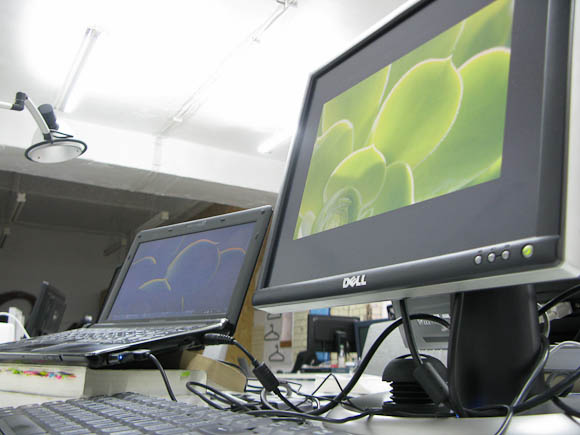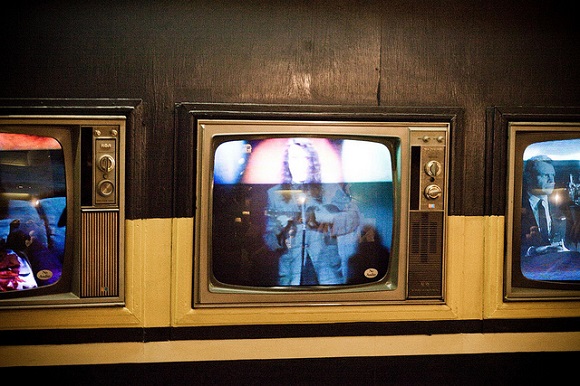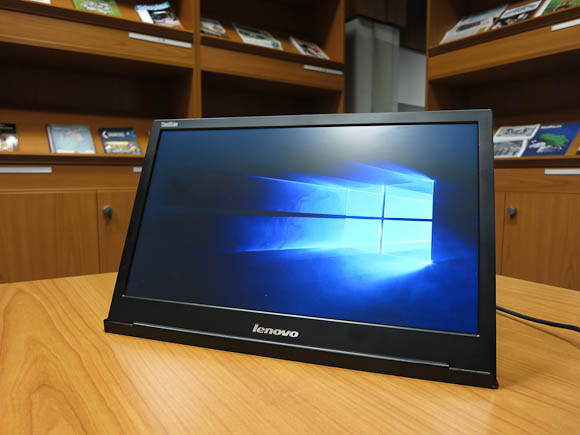I’ve heard it said that working with two screen looks a bit ridiculous, like you fancy yourself as some kind of ultra-efficient badass.A bit like this guy in The Onion.
But I’ve been working this way for about two years now, and for me there’s no going back. This is partly because I really do fancy myself as some kind of ultra-efficient badass, but it’s also because I just find it really fricking useful.
I only really went this way because I was using a 10” netbook, and the screen real estate was tiny, so I bought an external monitor to plug in. But now I’ve gone this way, it’s hard to imagine going back.
I suspect it’s one of those things where you can’t appreciate how good it is until you’ve tried it, like watching a film in surround sound, or serving cake with a chainsaw.
Two screens for a writer
There are some professions which naturally lend themselves to multiple screens. Video editors, for example, for whom two would be a low number, and four or five more common.
But I would say, any digital task that has other, peripheral tasks associated with it can potentially benefit from extra screen real estate, writing included.
To some writers this might seem unusual given the trend for minimalistic writing software. But my own writing often requires access to external materials. And the ability to keep my main task (i.e. writing) up front and centre, and uninterrupted, is really important. That’s how I maintain focus.
Here’s another writer that goes for multiple screens (the article is actually mainly an endorsement for the Scrivener writing application, but you still get a feel for her setup).
… when she is back at her writing desk, she has two screens set up, both running Scrivener. One screen is dedicated to writing, while the other is used for reference and displays her Series Bible.
My setup
Okay, so here’s how I usually work, albeit with my old netbook and a precarious pile of books as a stand.

More specifically, this is how I work:
Main screen (in front of me) – The main activity, usually writing.
Laptop screen (to one side) – Peripheral activities or information, such as the following:
- The structural layout for the book or blog post I’m writing.
- Photos of a physical location when I’m doing travel writing.
- Web browser with e.g. research resources for a blog post.
- A task timer (to keep me pushing on and remind me to take a break).
- A task list.
- A calendar.
- A music player (to help me get in the zone).
- Nothing – just desktop icons (for quick access).
Benefits
Here are the benefits that I’ve personally noticed.
Firstly, the fact that I have a screen right in front of me dedicated to the main task, means I never need to obscure it when task swapping or doing peripheral activities. This task swapping increases your cognitive load, as you have to remember the original task, switch to the new task, and then hopefully not get so caught up that you don’t forget to go back to the old task.
With two screens, my main screen has my writing on the whole time. So if I’m ever thinking ‘What was it I was doing again?’ the answer is simple. I don’t have to rely on my memory as to what I was doing.
Whatever is right in front of me – THAT’S what I’m doing.
There is an argument that when you’re writing, you should just do the writing and leave any peripheral tasks to the end. Flag them up with a digital highlighter and do them later. But as noted, for the kind of writing I do, this is not always ideal.
Secondly, having my task list and calendar, to one side, means I can quickly add things as I think about them, and hence forget about them, rather than getting mentally swept away.
Thirdly, on a similar note, having my task list and calendar open to one side stops me from forgetting whatever the heck it is I’m meant to be doing that day. For a task list to work, you have to remember to check it, and if it’s in my face then that’s so much easier.
Why not just go with one huge screen?
You can just go for a single huge screen, and many people do. But if you already have a laptop, and that’s your main work station, then a second screen – of whatever size – is the best idea.
Even if you do have a large external screen, and don’t necessarily need the real estate, it’s still worth using it as part of a pair, in my opinion, because then you have a stronger sense of compartmentalisation. This ties in with what I said before – having your main task right in front of you is a useful visual cue as to what is currently meant to be your focus.
A sporting problem
One common problem I have with a single screen is with sport. I’m not a huge sports fan, but I do like to keep an eye on some things, like Formula 1. With a single screen, I have to commit myself to just watching that. With two screens I can watch the Formula 1 and kid myself I’m also getting work done.
As I’m suggesting, this set up is more problematic as it involves multi-tasking. And there is apparently no such thing – only rapid task-swapping. And of the two things competing for my attention, one consists of moving images, and is always going to win out. But since I know that’s the case, I use the opportunity to get some low-intensity work done, like sorting out my reports for the month, or performing remote cranial surgery.
OMG they’re multiplying
One problem with a second monitor is that a lack of portability means I have to keep it at home, and, for me, working at home is the opposite of productive.
To solve this problem, I invested in a cheap(ish) portable monitor that I can take to the library or co-working space. It was either that or hire someone to hang around in my room, give me admonishing looks and say “That doesn’t look like work” every fifteen minutes. I figured the portable screen was cheaper.
I bought the Lenovo ThinkVision LT1421, and it’s been great so far (although the prices seem to fluctuate wildly, so it’s best searching amazon and judging for yourself).
The screen of the Lenovo is a bit washed out compared to a regular monitor, and the acceptable range of viewing angles is quite tight, but hey – it’s light, USB-powered and fits in my laptop bag, meaning I can look like the aforementioned ridiculous badass in workplaces all over the world.
On a side note, for a brief while, I found myself using this portable one as a third screen at home. But I decided to stop before I ended up encased in a planetarium-like dome of displays (and then writing an article about how much better my life is since I went down that road).
But it has its detractors…
It’s not all positives when it comes to using multiple monitors.
This NY Times article does a great take down on the use of two screens. Let me summarise it thus: If you are using both screens for genuine work tasks then great. If not then don’t do it, because you’re just distracting the crap out of yourself’, all of which it backs up with studies.
Endgame
I do still want more. Ever since I started writing in earnest, over a decade ago, I’ve been wanting a Minority Report style interface with which I could play about with book structure. A bit like Will Self achieves with post-it notes, although as you can see, it’s not something you can easily pack up and take with you:

(image from The Guardian)
No doubt all this will all become irrelevant at some point in the near future, given that display technology is advancing along with everything else. Indeed, even writing as a profession may bite the dust at some point – or at least be mightily squeezed – given the advent of automated writing software.[ http://www.theverge.com/2015/1/29/7939067/ap-journalism-automation-robots-financial-reporting}
But until then, I’ll keep churning out the words – and looking like a ridiculous badass as I go.
Do you work with a second screen, or can you procrastinate just fine with only the one? Please share your experiences in the comments below.
[Main image – TV room at Graceland (Flickr user Thomas Hawk]


Thanks for the insight. I was thinking about getting another monitor, and you presented points I will consider. Well written, too.
I’m a retired teacher that wants a side gig for extra money. I had a business that ruined my finances, so I am now a freelance writer. I love writing on my desktop, but also use a Surface.
Thanks to this article, I’ll connect them to see if I get distracted or if it works productively for my style if writing.
All the best with it! I wrote this blog post some years ago, but I still love working with a second screen